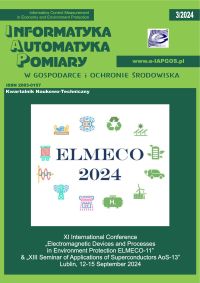POMIAR CZASU MARTWEGO METODĄ DWÓCH ŹRÓDEŁ – OPTYMIZACJA PODZIAŁU CZASU POMIARU
Grzegorz Domański
g.domanski@ire.pw.edu.plPolitechnika Warszawska (Polska)
Bogumił Konarzewski
Politechnika Warszawska (Polska)
Robert Kurjata
Politechnika Warszawska (Polska)
Krzysztof Zaremba
Politechnika Warszawska (Polska)
Janusz Marzec
Politechnika Warszawska (Polska)
Michał Dziewiecki
Politechnika Warszawska (Polska)
Marcin Ziembicki
Politechnika Warszawska (Polska)
Andrzej Rychter
Politechnika Warszawska (Polska)
Waldemar Smolik
Politechnika Warszawska (Polska)
Roman Szabatin
Politechnika Warszawska (Polska)
Piotr Brzeski
Politechnika Warszawska (Polska)
Abstrakt
W artykule zaprezentowano analizę pomiaru czasu martwego detektora nieparaliżowalnego metodą dwóch źródeł. Wyznaczono optymalny podział czasu pomiaru częstości zliczeń dla pomiaru jednym i dwoma źródłami. Wyniki pracy mogą być wykorzystane do optymalizacji systemów zliczających fotony lub cząstki.
Słowa kluczowe:
czas martwy, częstość zliczeń, metoda dwóch źródełBibliografia
Knoll G.F.: Radiation Detection and Measurement (4th ed.). Willey, 2010.
Google Scholar
Meeks C., Siegel P.B.: Dead time correction via the time series. Am. J. Phys. 76 (6), 2008, 589–590 [DOI: 10.1119/1.2870432].
Google Scholar
Myers R.T.: Dead Time of a Geiger-Mueller Tube by the Double-Source Method. Journal of Chemical Education 33(8), 1956, 395–396 [DOI: 10.1021/ed033p395].
Google Scholar
Autorzy
Bogumił KonarzewskiPolitechnika Warszawska Polska
Autorzy
Robert KurjataPolitechnika Warszawska Polska
Autorzy
Krzysztof ZarembaPolitechnika Warszawska Polska
Autorzy
Janusz MarzecPolitechnika Warszawska Polska
Autorzy
Michał DziewieckiPolitechnika Warszawska Polska
Autorzy
Marcin ZiembickiPolitechnika Warszawska Polska
Autorzy
Andrzej RychterPolitechnika Warszawska Polska
Autorzy
Waldemar SmolikPolitechnika Warszawska Polska
Autorzy
Roman SzabatinPolitechnika Warszawska Polska
Autorzy
Piotr BrzeskiPolitechnika Warszawska Polska
Statystyki
Abstract views: 246PDF downloads: 88
Licencja

Utwór dostępny jest na licencji Creative Commons Uznanie autorstwa – Na tych samych warunkach 4.0 Miedzynarodowe.
Inne teksty tego samego autora
- Jacek Kryszyn, Waldemar Smolik, PAKIET DO TRÓJWYMIAROWEGO MODELOWANIA I REKONSTRUKCJI OBRAZÓW W ELEKTRYCZNEJ TOMOGRAFII POJEMNOŚCIOWEJ , Informatyka, Automatyka, Pomiary w Gospodarce i Ochronie Środowiska: Tom 7 Nr 1 (2017)
- Mateusz Midura, Przemysław Wróblewski, Damian Wanta, Grzegorz Domański, Mateusz Stosio, Jacek Kryszyn, Waldemar T. Smolik, SYSTEM DO POMIARU ZESPOLONEJ PODATNOŚCI MAGNETYCZNEJ NANOCZĄSTEK Z WYKONANYM W TECHNOLOGII DRUKU 3D KARKASEM ZINTEGROWANYCH CEWEK ODBIORCZYCH , Informatyka, Automatyka, Pomiary w Gospodarce i Ochronie Środowiska: Tom 11 Nr 1 (2021)
- Jacek Kryszyn, Waldemar Smolik, Tomasz Olszewski, Roman Szabatin, ROZWÓJ KONSTRUKCJI ELEKTRYCZNEGO TOMOGRAFU POJEMNOŚCIOWEGO W ZAKŁADZIE ELEKTRONIKI JĄDROWEJ I MEDYCZNEJ , Informatyka, Automatyka, Pomiary w Gospodarce i Ochronie Środowiska: Tom 7 Nr 1 (2017)
- Waldemar Smolik, Jacek Kryszyn, Tomasz Olszewski, Roman Szabatin , METODY POMIARU MAŁYCH POJEMNOŚCI W ELEKTRYCZNEJ TOMOGRAFII POJEMNOŚCIOWEJ , Informatyka, Automatyka, Pomiary w Gospodarce i Ochronie Środowiska: Tom 7 Nr 1 (2017)
- Jacek Kryszyn, Waldemar Smolik, DWUWYMIAROWE MODELOWANIE SONDY DO ELEKTRYCZNEJ TOMOGRAFII POJEMNOŚCIOWEJ W PAKIECIE ECTSIM , Informatyka, Automatyka, Pomiary w Gospodarce i Ochronie Środowiska: Tom 7 Nr 1 (2017)
- Przemysław Wróblewski, Waldemar Smolik, KONSTRUKCJA CEWKI Z WYKORZYSTANIEM LICA DO SPEKTROMETRII CZĄSTEK MAGNETYCZNYCH , Informatyka, Automatyka, Pomiary w Gospodarce i Ochronie Środowiska: Tom 7 Nr 1 (2017)
- Grzegorz Domański, Roman Szabatin, Jerzy Kalenik, Adam Jaworski, Przemysław Wróblewski, Waldemar Smolik, Robert Kurjata, Bogusław Konarzewski, Michał Dziewiecki, Janusz Marzec, Krzysztof Zaremba, Marcin Ziembicki, Andrzej Rychter, Jacek Kryszyn, Piotr Brzeski, Jan Szmidt, TEORIA WZMOCNIENIA JEDNOFOLIOWEGO DETEKTORA Z GAZOWYM POWIELANIEM ELEKTRONÓW , Informatyka, Automatyka, Pomiary w Gospodarce i Ochronie Środowiska: Tom 7 Nr 1 (2017)
- Waldemar Smolik, Jacek Kryszyn, PRZEDZIAŁAMI LINIOWE ITERACYJNE ALGORYTMY REKONSTRUKCJI OBRAZÓW W ELEKTRYCZNEJ TOMOGRAFII POJEMNOŚCIOWEJ , Informatyka, Automatyka, Pomiary w Gospodarce i Ochronie Środowiska: Tom 7 Nr 1 (2017)
- Przemysław Wróblewski, Waldemar Smolik, ROZWÓJ TOMOGRAFII NANOCZĄSTECZEK MAGNETYCZNYCH W ZAKŁADZIE ELEKTRONIKI JĄDROWEJ I MEDYCZNEJ , Informatyka, Automatyka, Pomiary w Gospodarce i Ochronie Środowiska: Tom 7 Nr 1 (2017)
- Grzegorz Domański, Roman Szabatin, Piotr Brzeski, Bogumił Konarzewski, DETEKTOR IGŁOWY PROMIENIOWANIA X I GAMMA , Informatyka, Automatyka, Pomiary w Gospodarce i Ochronie Środowiska: Tom 7 Nr 1 (2017)








